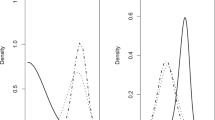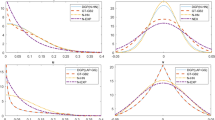Abstract
The corrected ordinary least squares (COLS) estimator of the stochastic frontier model exploits the higher order moments of the OLS residuals to estimate the parameters of the composed error. However, both “Type I” and “Type II” failures in COLS can result from finite sample bias that arises in the estimation of these higher order moments, especially in small samples. We propose a novel modification to COLS by using the first moment of the absolute value of the composite error term in place of the third moment for both the Normal-Half Normal and Normal-Exponential specifications. We demonstrate via simulations that this switch considerably reduces the occurrence of both Type I and Type II failures. These Monte Carlo simulations also reveal that our alternative COLS approach, in general, performs better than standard COLS.
Similar content being viewed by others
Notes
In the production (cost) frontier, Type I failure means the OLS residuals produce a positive (negative) skewness while a negative (positive) skewness is anticipated.
For example, in the Normal-Half Normal specification, Papadopoulos and Parmeter (2021) show that a Type II Failure implies that the absolute value of the estimated skewness exceeds the maximum of the absolute value of the skewness that the Normal-Half Normal composite error term could have; i.e., while the maximum of the absolute value of skewness for the Skew Normal distribution is 0.995, the estimated skewness is smaller than \(-0.995\) in the production frontier or larger than 0.995 in the cost frontier.
We thank Alecos Papadopoulos for suggesting this acronym.
Proposition 2.1 is equivalent to saying that the square of a Skew Normal random variable is a \(\chi ^2\) random variable with one degree of freedom, which is stated as Property H in Azzalini (1985). This proposition has also been “proven” more recently: See Jradi et al. (2019, Theorem 1), and Huang and Chen (2007, Proposition 4); both without attribution to Azzalini’s work.
In Subsection A.1 of the separate Appendix A, we provide several explanations on the restriction \({\widehat{\sigma }}_u \in [0,(\frac{\pi \widehat{r}_2}{\pi -2})^{\frac{1}{2}}]\) for the Normal-Half Normal specification.
See Proposition 2.1 in Zhao and Parmeter (2022) for the proof.
In Subsection A.2 of the separate Appendix A, we provide further discussion on the restriction \({{\widehat{\lambda }}}_I \ge 0\) for the Normal-Exponential specification.
See Appendix B for more details about estimating individual efficiency \({\widehat{E}}\left[ \exp (-u_i)\mid \widehat{\varepsilon }_i\right] \).
For more details, see Hafner et al. (2018).
References
Aigner D, Lovell CAK, Schmidt P (1977) Formulation and estimation of stochastic frontier production function models. J Econom 6:21–37
Almanidis P, Sickles RC (2011) The skewness issue in stochastic frontiers models: Fact or fiction? In: Van Keilegom I, Wilson PW (eds) Exploring research frontiers in contemporary statistics and econometrics. Springer, Berlin, pp 201–227
Almanidis P, Qian J, Sickles RC (2014) Stochastic frontier models with bounded inefficiency. In: Sickles RC, Horrace WC (eds) Festschrift in honor of peter Schmidt: econometric methods and applications. Springer, New York, pp 47–81
Azzalini A (1985) A class of distributions which includes the Normal ones. Scand J Stat 12:171–178
Azzalini A (1986) Further results on a class of distributions which includes the normal ones. Statistica (Bologna) 46:199–208
Badunenko O, Henderson DJ (2021) Production analysis with asymmetric error. Paper presented at Virtual North American Productivity Workshop 2021
Battese GE, Coelli TJ (1988) Prediction of firm-level technical efficiencies with a generalized frontier production function and panel data. J Econom 38:387–399
Bonanno G, De Giovanni D, Domma F (2015) The wrong skewness problem: a re-specification of stochastic frontiers. J Prod Anal 47:49–64
Cai J, Feng Q, Horrace WC, Wu GL (2021) Wrong skewness and finite sample correction in the normal-half normal stochastic frontier model. Empir Econ 60:2837–2866
Carree MA (2002) Technological inefficiency and the skewness of the error component in stochastic frontier analysis. Econ Lett 77:101–107
Coelli T (1995) Estimators and hypothesis tests for a stochastic frontier function: a Monte Carlo analysis. J Prod Anal 6:247–268
Greene WH (1990) A Gamma-distributed stochastic frontier model. J Econom 46:141–163
Greene WH (2007) Matching the matching estimators. Unpublished working paper. Department of Economics, Stern School of Business, New York University
Hafner CM, Manner H, Simar L (2018) The wrong skewness problem in stochastic frontier models: a new approach. Econom Rev 37:380–400
Horrace WC (2015) Moments of the truncated normal distribution. J Prod Anal 43:133–138
Horrace WC, Parmeter CF (2018) A Laplace stochastic frontier model. Econom Rev 37:260–280
Horrace WC, Wright IA (2020) Stationary points for parametric stochastic frontier models. J Bus Econ Stat 38:516–526
Horrace WC, Parmeter CF, Wright IA (2022) On asymmetry and quantile estimation of the stochastic frontier model. University of Miami Working Paper
Huang W-J, Chen Y-H (2007) Generalized skew-Cauchy distribution. Stat Prob Lett 77:1137–1147
Jradi S, Parmeter CF, Ruggiero J (2019) Quantile estimation of the stochastic frontier model. Econ Lett 182:15–18
Jradi S, Parmeter CF, Ruggiero J (2021) Quantile estimation of stochastic frontiers with the normal-exponential specification. Eur J Oper Res 295:475–483
Kumbhakar SC, Parmeter CF, Zelenyuk V (2020a) Stochastic frontier analysis: foundations and advances I. In: Ray SC, Chambers R, Kumbhakar S (eds) Handbook of production economics. Springer, Singapore, pp 1–39
Kumbhakar SC, Parmeter CF, Zelenyuk V (2020b) Stochastic frontier analysis: foundations and advances II. In: Ray SC, Chambers R, Kumbhakar S (eds) Handbook of production economics. Springer, Singapore, pp 1–38
Li Q (1996) Estimating a stochastic production frontier when the adjusted error is symmetric. Econ Lett 52:221–228
Meeusen W, van den Broeck J (1977) Efficiency estimation from Cobb–Douglas production functions with composed error. Int Econ Rev 18:435–444
Olson JA, Schmidt P, Waldman DM (1980) A Monte Carlo study of estimators of stochastic frontier production functions. J Econom 13:67–82
Papadopoulos A, Parmeter CF (2021) Type II failure and specification testing in the stochastic frontier model. Eur J Oper Res 293:990–1001
Schmidt P, Lin T-F (1984) Simple tests of alternative specifications in stochastic frontier models. J Econom 24:349–361
Simar L, Wilson PW (2009) Inferences from cross-sectional, stochastic frontier models. Econom Rev 29:62–98
Simar L, Wilson PW (2022) Nonparametric, stochastic frontier models with multiple inputs and outputs. J Bus Econ Stat (forthcoming)
Simar L, Van Keilegom I, Zelenyuk V (2017) Nonparametric least squares methods for stochastic frontier models. J Prod Anal 47:189–204
Wei Z, Zhu X, Wang T (2021) The extended skew-normal-based stochastic frontier model with a solution to ‘wrong skewness’ problem. Statistics (Forthcoming)
Zhao S (2021) Quantile estimation of stochastic frontier models with the normal-half normal specification: a cumulative distribution function approach. Econ Lett 206:109998
Zhao S, Parmeter CF (2022) The wrong skewness problem: moment constrained maximum likelihood estimation of the stochastic frontier model. Econom Lett 221:110901
Zhu X, Wei Z, Wang T (2022) Multivariate skew normal-based stochastic frontier models. J Stat Theory Pract 16:1–21
Author information
Authors and Affiliations
Corresponding author
Ethics declarations
Conflict of interest
All authors declare that they have no conflicts of interest.
Ethical approval
This article does not contain any studies with human participants or animals performed by any of the authors.
Additional information
Publisher's Note
Springer Nature remains neutral with regard to jurisdictional claims in published maps and institutional affiliations.
We thank participants at vAPW 2021 for valuable feedback as well as Alecos Papadopoulos, William Greene, and Robin Sickles for useful comments which improved the paper. We thank the Cyber Infrastructure Technology Integration group at Clemson University for operating the Palmetto cluster used for computations. Shirong Zhao acknowledges the support from Liaoning Social Science Foundation (L22CJY011) and Liaoning Provincial Department of Education Research Fund (LJKMZ20221602). All the authors contributed equally. All errors are our own.
Supplementary Information
Below is the link to the electronic supplementary material.
Rights and permissions
Springer Nature or its licensor (e.g. a society or other partner) holds exclusive rights to this article under a publishing agreement with the author(s) or other rightsholder(s); author self-archiving of the accepted manuscript version of this article is solely governed by the terms of such publishing agreement and applicable law.
About this article
Cite this article
Parmeter, C.F., Zhao, S. An alternative corrected ordinary least squares estimator for the stochastic frontier model. Empir Econ 64, 2831–2857 (2023). https://doi.org/10.1007/s00181-023-02401-1
Received:
Accepted:
Published:
Issue Date:
DOI: https://doi.org/10.1007/s00181-023-02401-1




